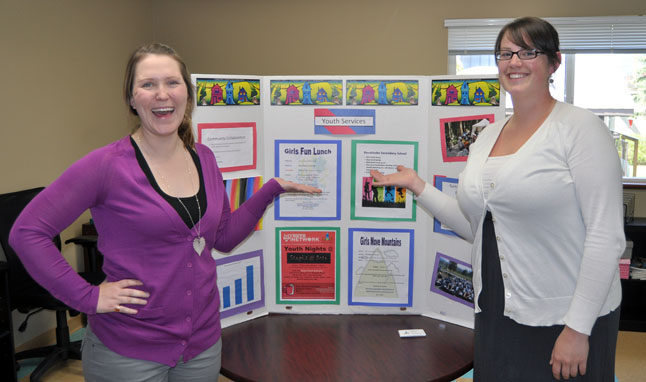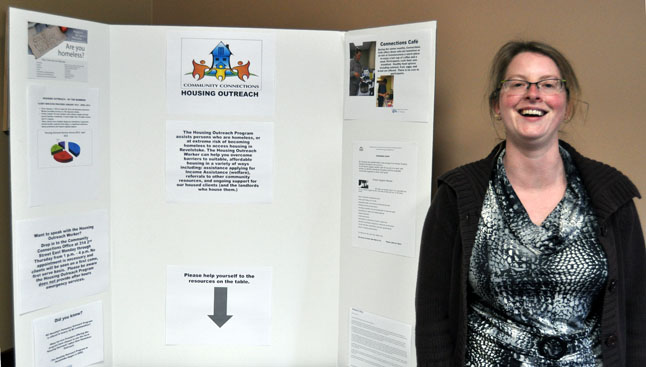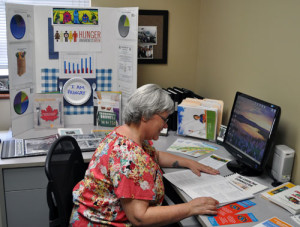By David F. Rooney
Change seems to be a never-ending process at Community Connections.
Over the past several months the social service agency has undergone personnel changes and has had to cope with tightened finances.
But those unwanted changes are forcing its dedicated and hard-working staff to be creative and to do more with less.

That determination was evident during last week’s Open House when members of the public were invited to drop in, meet the staff and discover more about Community Connections.
“It’s a bit of a learning curve,” said Diane Gadbois, Community Connections’ finance and administration director.
“My vision is that though we’re a non-profit we should be run as a business. With the funding cuts we’ve had to go through we have had to change the way we do a lot of things.”
Those funding cuts are important. In 2011, the agency had revenues of $2.972 million and expenses of $3.028 million. Last year its revenues dropped to $2.626 million and its expenses were cut to $2.674 million. That was a tough blow to an organization that already saw some of its major programs such as the Food Bank, Social Justice Advocacy program and the Summer Day Camp getting by with no core government support or funding.
“Change though is never ending and we have recently been faced with the need to make a further changes to our organization t reduce costs, including reducing the number of senior managers to ensure a balanced budget,” said Executive Director Craig Brown. “That means the remaining managers will have to take on even more work and responsibilities, but does ensure that we don’t need to cut direct services to our clients.”
He said Community Connections has always had funding issues and has worked with deficits in the past so it will just have to find ways to work with them now and into the future.
“We’ve had 175 new intakes since the beginning of the year,” he said. “That’s huge and we’re doing it with no increase in funding — not even a cost of living adjustment. Take a look at the Food Bank. We have the equivalent of two full classrooms of kids coming to the food bank. We’re feeding them without any government assistance of any kind. We’re an organization that is living on the edge in terms of dollars.”
That’s tough so you have to wonder about Community Connections’ success. It’s pretty simple, senior management beats the bushes for every spare dime they can find and its staff members are passionate about the services they offer their clients, many of whom are the most vulnerable residents in our city.

Take the agency’s Community Living Services for Children. “We work with autistic children and kids with disabilities,” says Andree Rioux.
She and co-workers Kaitlin Larson and Erin MacLachlan see about 30 kids between the ages of three and 18 on a regular basis.
“It’s relational,” Andree said. “Every child is different and as we work with them we build really long relationships with them and their families.”

It’s the same over in Counseling where Sheena Bell and Laura Kanik between 80 and 100 people a week for a wide variety of reasons. For instance, some of the people between the ages of 25 and 40 who come here for seasonal work would really like to find a niche for themselves in Revelstoke society yet have difficulty finding acceptance. That may seem unusual, given Revelstoke’s reputation as friendly and hospitable town but those of us who have moved here over the last 10 or 12 years may be able empathize. People can be superficially friendly but finding an accepted place in our society can take a long time to achieve.
And sometimes finding a place to call your own can be even more difficult.

“I never know what’s coming through the door,” said Melissa Jameson, the agency’s Housing Outreach coordinator.
She deals with 183 people who need stable housing in our community. Many of these people are young adults between the ages of 19 and 25.
“Some of them are unrealistic,” she said, “Even things as basic as getting them to make budgets and have realistic expectations can be challenging. It can be hard to get then look at what they can afford.”

Community Connections applies for a lot of grants and specific programs like the Food Bank rely heavily on private donations and help from the provincial and national Food Bank organizations while the Summer Day Camp program relies on help from service clubs and the City’s Grant-in-Aid program.
That’s not to say it all of its programs are not government supported. In fact Community Connections received $2 million from the province in 2012, down from $2.3 million in 2011 but the hundreds of thousands of other dollars it receives come from foundations, grants and other sources.
But when governments don’t like to talk about poverty and destitution in Canada how do you keep going when your organizations needs “are not on anybody’s radar?”



